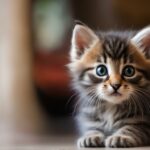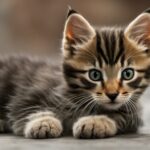Cats, those adorable and mysterious creatures that grace our homes, have a special affinity for pats and affection. As a cat owner, you might have experienced the joy of watching your feline friend purr contentedly while being gently stroked. But have you ever wondered why cats love pats so much? Let’s explore the fascinating world of feline affection and learn what makes these creatures so drawn to our touch.
From the warmth of their purrs to the gentle nuzzles, cats have their own unique way of expressing love and forming bonds with their human companions. In this article, we will unravel the psychology behind their affectionate behavior and uncover the reasons why cats seek out pats and physical contact. So, grab a cup of tea, curl up with your favorite feline friend, and let’s embark on this delightful journey of understanding our beloved pets.
Key Takeaways:
- Cats enjoy pats and affection as a means of social bonding and strengthening their emotional connection with their owners.
- Petting provides sensory pleasure for cats, activating the release of feel-good hormones and promoting relaxation.
- Body language and communication are essential in understanding a cat’s affectionate behavior, with rubbing and purring being common signals.
- Kneading is a behavior often associated with attention-seeking, relaxation, and bonding, rooted in a cat’s instinctive behaviors from kittenhood.
- Respecting a cat’s individual preferences and providing positive reinforcement can encourage positive affectionate behaviors.
Understanding Feline Social Bonding
Cats are known for their independent nature and are often perceived as less social than dogs. However, they still form social bonds, albeit in a different way. Feline social bonding is influenced by various factors, including behavior, grooming, and trust.
Grooming plays a significant role in feline social bonding. Cats groom each other to establish and maintain social connections. This behavior helps to build trust and strengthen the bond between cats. Similarly, when we pet our cats, we are providing them with social and tactile stimulation, which can enhance their sense of security and deepen the emotional connection between us.
By offering physical contact through petting, we create an opportunity for cats to engage in social behavior that they may not experience with other cats. This interaction can help them feel safe and loved, and it reinforces the bond they share with their human companions. Understanding and respecting the importance of grooming and physical contact in feline social bonding is crucial for nurturing a strong and harmonious relationship with our cats.
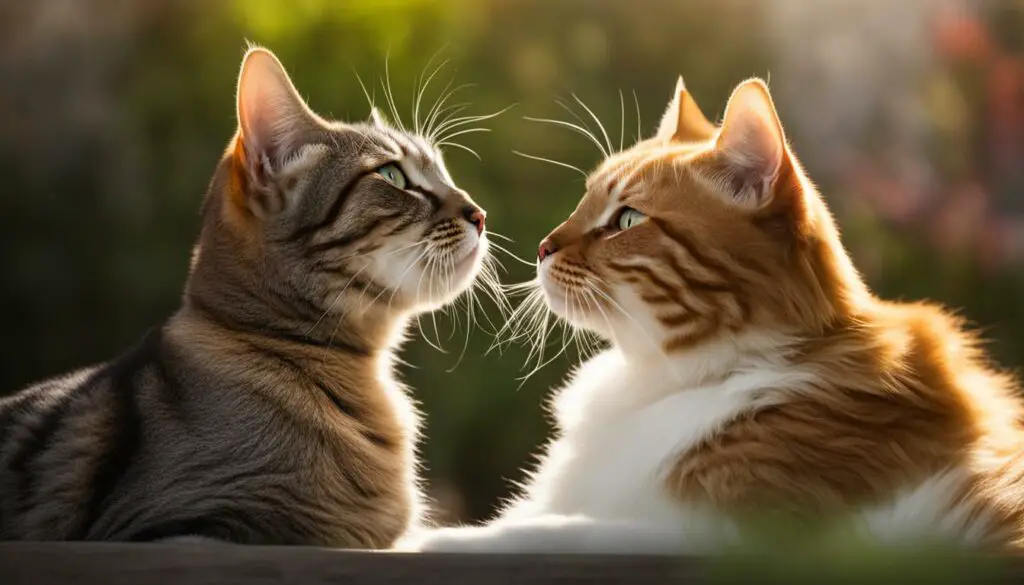
Understanding Feline Social Bonding
Feline social bonding is influenced by various factors, including behavior, grooming, and trust. Cats may not be as social as dogs, but they still form strong connections with their human companions. By petting them, we provide them with social and tactile stimulation, which strengthens the bond between us.
“By offering physical contact through petting, we create an opportunity for cats to engage in social behavior that they may not experience with other cats.”
Grooming plays a significant role in feline social bonding. When cats groom each other, they establish trust and reinforce their social connections. By petting our cats, we mimic this grooming behavior, which helps build trust and enhances the emotional bond between us.
Understanding the importance of grooming and physical contact in feline social bonding allows us to foster strong and positive relationships with our cats. By providing them with love, affection, and the opportunity for social interaction, we can create a bond based on trust and mutual understanding.
| Factors Influencing Feline Social Bonding | |
|---|---|
| Grooming | Establishes trust and strengthens social connections |
| Behavior | Allows cats to engage in social behavior with their human companions |
| Grooming and Physical Contact | Enhances emotional bond and sense of security |
The Pleasure of Tactile Stimulation
When it comes to cats, the power of touch is undeniable. Cats possess specialized sensory receptors that respond to touch, making tactile stimulation a source of pleasure for them. Petting their fur activates these receptors, triggering a cascade of feel-good chemicals in their brains. This sensory experience can be incredibly enjoyable for cats, leading to feelings of pleasure and relaxation.
Research has shown that petting a cat can activate the release of dopamine, endorphins, and oxytocin – neurotransmitters associated with pleasure, pain relief, and emotional bonding. These chemicals not only enhance the cat’s mood but also contribute to their overall well-being. By engaging in gentle pats, we can provide cats with a pleasurable sensory experience that strengthens our bond with them.
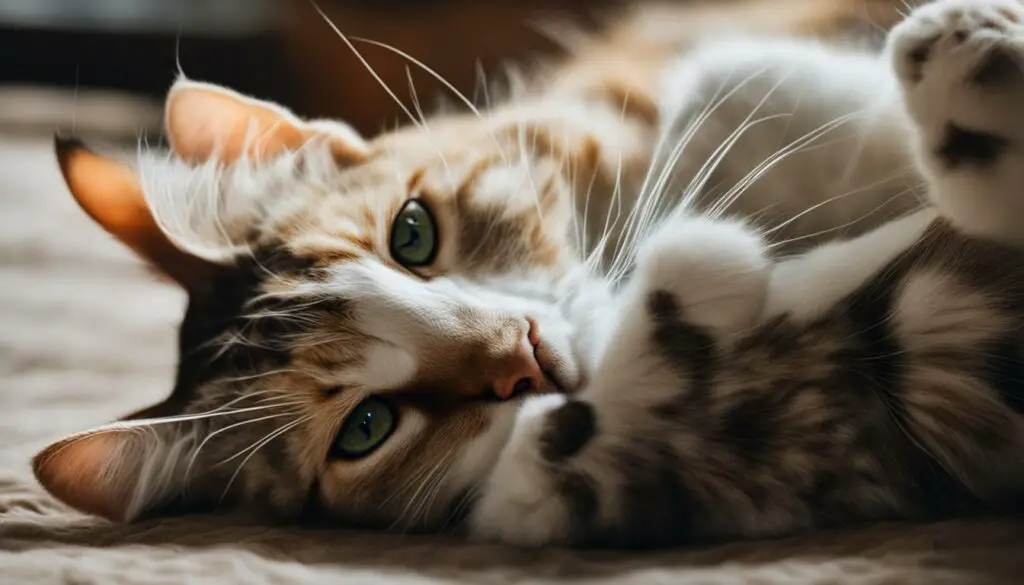
“For many cats, the power of touch is not only pleasurable but also deeply soothing,” explains Dr. Emily Johnson, a veterinarian specializing in feline behavior. The act of petting releases tension and promotes relaxation, allowing cats to feel safe and secure in their environment.” This explains why many cats seek out human-animal interaction and actively solicit pats from their human companions.
So, the next time your furry friend curls up beside you, remember that your touch has the power to bring them immense pleasure. Take a moment to enjoy the sensations of their soft fur under your hand, knowing that you are providing them with a sensory experience that enhances their well-being and strengthens your bond.
The Language of Cats: Body Language and Communication
Cats have a unique way of communicating, and understanding their body language is key to decoding their messages. When a cat rubs against you, it is a sign of affection and territorial marking. This behavior, known as bunting, allows them to leave their scent on you, marking you as their territory. It’s their way of saying, “This human is mine!”
Purring is another form of communication that cats use to express contentment and relaxation. It’s a soothing sound that is often associated with happiness. While purring is commonly understood as a sign of pleasure, cats also purr when they are anxious or in pain, so it’s important to consider other body language cues to interpret their overall state of mind.
“A cat’s body language can tell you a lot about how they are feeling. Pay attention to their ears, tail, and whiskers to get a sense of their mood,” says Dr. Emily Williams, a feline behavior specialist.
It’s important to note that not all forms of feline communication are verbal. Cats use subtle body movements and facial expressions to convey their emotions. For example, flattened ears and a twitching tail may indicate that a cat is feeling defensive or agitated, while relaxed whiskers and a slow blink can signal contentment. By paying attention to these non-verbal cues, you can better understand and communicate with your feline friend.
The Language of Cats: Body Language and Communication
| Body Language | Meaning |
|---|---|
| Rubbing against you | Affection and territorial marking |
| Purring | Contentment and relaxation |
| Flattened ears and twitching tail | Defensiveness or agitation |
| Relaxed whiskers and slow blink | Contentment |
By understanding the language of cats, you can deepen your bond with your feline companion and ensure that you are meeting their emotional and physical needs. Just as we use words to communicate, cats use their body language to express themselves. So the next time your cat rubs against you or purrs in your presence, remember that they are communicating their love and trust in their own unique way.
The Art of Kneading
One fascinating behavior exhibited by cats is kneading, where they rhythmically push their paws into a soft surface. Kneading is often associated with attention-seeking, relaxation, and bonding. This behavior is thought to stem from kittenhood, where cats knead their mothers to promote milk flow. Over time, kneading has evolved into a comforting and soothing activity for cats, as well as a way to express their affection towards their human companions.
Kneading offers several benefits for cats. Firstly, it serves as a form of attention-seeking behavior. When cats knead, they seek interaction and engagement from their owners, signaling that they desire affection and companionship. Additionally, kneading promotes relaxation in cats. The rhythmic motion of pushing their paws against a surface can have a calming effect, helping cats to unwind and destress. Lastly, kneading strengthens the bond between cats and their owners. By engaging in this behavior, cats are actively participating in an affectionate activity that fosters a deeper emotional connection with their human companions.
To fully understand and appreciate the art of kneading, let’s take a look at a table highlighting the key aspects of this behavior:
| Aspects of Kneading | Description |
|---|---|
| Attention-seeking | Kneading is a way for cats to seek interaction and attention from their owners. |
| Relaxation | The rhythmic motion of kneading can have a calming effect on cats, promoting relaxation and stress relief. |
| Bonding | Kneading is an affectionate behavior that strengthens the emotional bond between cats and their owners. |
| Instinctive behavior | Kneading is a natural instinct in cats, starting from kittenhood as a way to promote milk flow during nursing. |
Understanding and appreciating the art of kneading can help cat owners forge deeper connections with their feline companions. By recognizing kneading as a form of attention-seeking, relaxation, and bonding, pet owners can respond appropriately to their cats’ needs and provide a nurturing environment for their beloved pets.
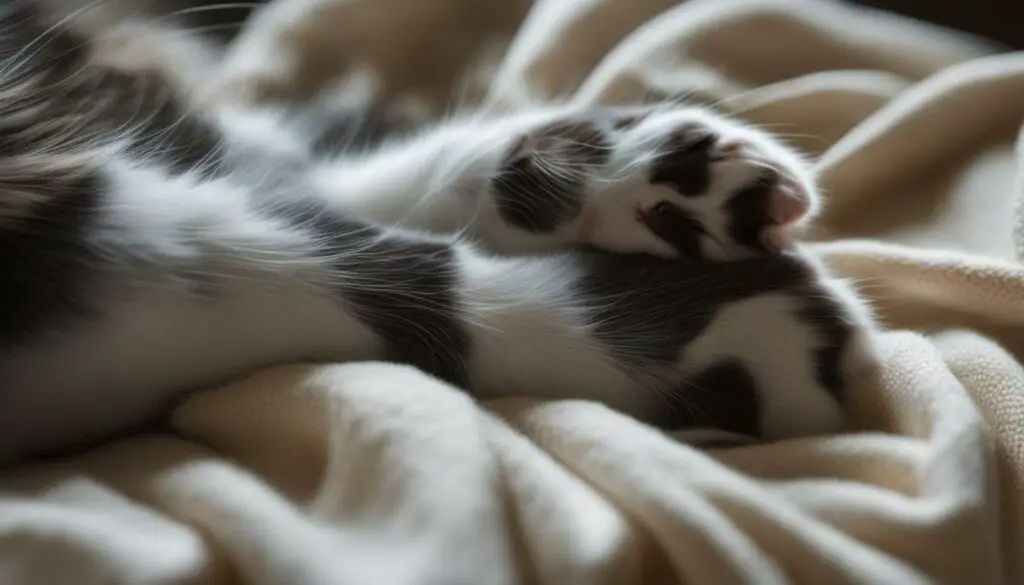
Feline Affection Through Touch
When it comes to expressing their love and trust, cats often rely on physical contact, particularly through pats and gentle strokes. Touch is an essential aspect of feline affection, allowing cats to form a deep emotional connection with their human companions.
For many cats, being touched by their owners brings a sense of relaxation and comfort. The soothing nature of touch helps them feel safe and secure, strengthening the bond between cats and their owners. This emotional connection is crucial in building a loving and trusting relationship.
Petting not only provides physical stimulation but also allows cats to express their love and affection. The act of petting releases feel-good hormones in cats, such as oxytocin, which further enhances the positive emotional response. Through touch, cats communicate their feelings of love and establish a sense of closeness with their owners.
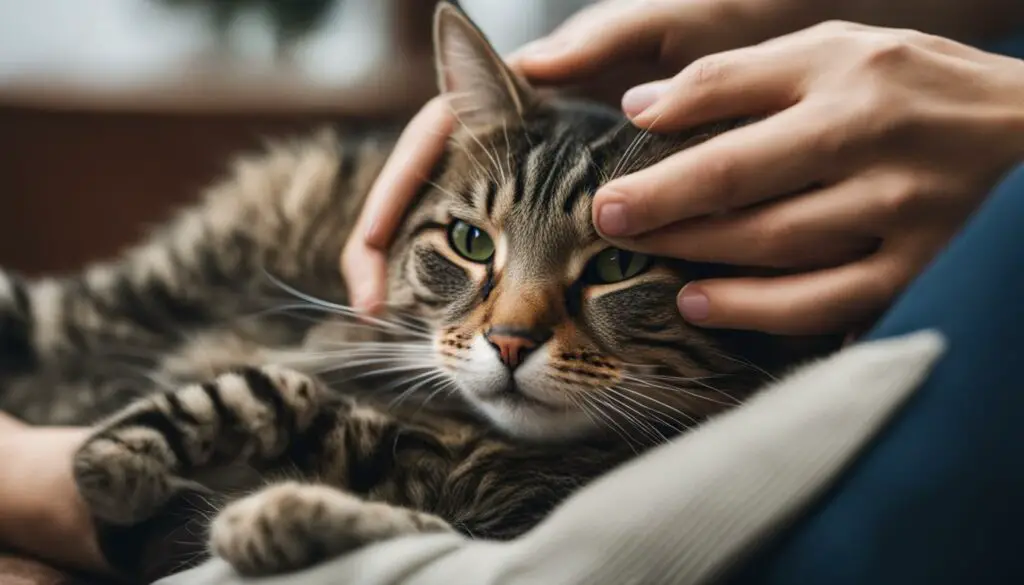
The Benefits of Touch for Cats
Physical contact with their owners offers various benefits for cats. It helps reduce stress and anxiety, promotes relaxation, and can even alleviate physical discomfort. Regular gentle touch can also improve the overall well-being of cats, enhancing their quality of life.
By understanding the importance of touch in feline affection, cat owners can create a nurturing environment that supports their cats’ emotional needs. Taking the time to provide gentle pats and strokes can make a significant difference in strengthening the bond and building trust with your feline companion.
| Benefits of Touch for Cats |
|---|
| Reduces stress and anxiety |
| Promotes relaxation |
| Alleviates physical discomfort |
| Improves overall well-being |
Remember that each cat is unique, and their preferences for touch may vary. Pay attention to your cat’s body language and cues to ensure they are comfortable and enjoying the affectionate touch. Taking the time to understand and respect their boundaries will help cultivate a loving and trusting relationship based on mutual understanding.
Next, we will explore the challenges that can arise with petting and discuss how to manage petting-related aggression in cats.
Understanding Petting-Related Aggression
Petting-induced aggression in cats can be a perplexing behavior for many cat owners. While most cats enjoy the affectionate touch of their human companions, some may display signs of aggression during petting sessions. Understanding the underlying causes can help manage and prevent such behaviors.
One possible reason for petting-induced aggression is the cat’s sensitivity threshold. Some cats have a lower tolerance for prolonged or intense petting. When their threshold is exceeded, they may react defensively by biting or scratching. It’s important to pay attention to your cat’s body language and cues, such as tail flicking, flattened ears, or dilated pupils, which may indicate discomfort or the need for a break.
Pain-related issues can also contribute to petting-induced aggression. Cats experiencing pain or discomfort, whether due to an injury or an underlying health condition, may not appreciate petting in certain areas. If you notice your cat showing signs of discomfort during petting, it is advisable to consult a veterinarian to rule out any medical issues.
| Common Triggers for Petting-Related Aggression: | Management Strategies: |
|---|---|
| Overstimulation due to excessive petting | Respect your cat’s boundaries and provide breaks during petting sessions. |
| Undesirable petting techniques, such as rough or forceful stroking | Use gentle and soothing strokes, focusing on areas your cat enjoys. |
| Pain or discomfort in specific areas | Consult a veterinarian to address any underlying medical issues. |
| Desire for control or lack of predictability | Allow your cat to initiate and end petting sessions, providing a sense of control. |
Remember, each cat is unique, and what triggers petting-induced aggression can vary. By observing your cat’s behavior, being attuned to their boundaries, and making adjustments to your petting techniques, you can help create a more positive and enjoyable experience for both you and your furry friend.
Managing Petting-Related Aggression
When it comes to dealing with petting-related aggression in cats, a proactive approach can make a significant difference in promoting a harmonious relationship with your feline companion. Here are some strategies for managing and preventing aggression:
- Veterinary Examination: If your cat exhibits sudden or frequent aggression during petting, it is crucial to have them examined by a veterinarian. They can rule out any underlying medical conditions or pain-related issues that may be contributing to the aggression.
- Recognizing Warning Signs: Understanding the warning signs of aggression is essential in preventing aggressive episodes. Pay attention to your cat’s body language, such as flattened ears, twitching skin, or dilated pupils. These signs indicate discomfort or the approaching of their tolerance threshold.
- Counter-Conditioning: Counter-conditioning techniques can help modify your cat’s response to petting. Gradually expose your cat to brief and gentle petting sessions, rewarding them with treats or praise for staying calm. Over time, this can help them associate petting with positive experiences.
It is important to note that each cat is unique, and what may work for one cat may not be effective for another. If you are struggling with managing petting-related aggression, consulting with a professional animal behaviorist can provide tailored guidance and support.
Remember, patience, understanding, and respect for your cat’s boundaries are key in fostering a trusting and affectionate bond with your feline friend.

Note: The image above depicts a calm and relaxed cat, promoting a peaceful connection with their human companion.
The Fascination with Kneading
Kneading is an instinctive behavior in cats that begins during kittenhood. This rhythmic motion involves pushing their paws into a soft surface, often accompanied by a gentle kneading motion. While the exact reason for kneading is not fully understood, it is thought to serve multiple purposes.
One of the main reasons cats knead is to stimulate milk flow during nursing. As kittens, they knead their mother’s mammary glands to promote the release of milk. This instinctive behavior helps them receive the nourishment they need for growth and development.
In addition to its association with nursing, kneading also promotes relaxation and stretching for cats. This rhythmic motion provides a soothing effect and may help them unwind and prepare for sleep. Furthermore, kneading helps stretch and flex the muscles in their paws, promoting overall physical wellbeing.
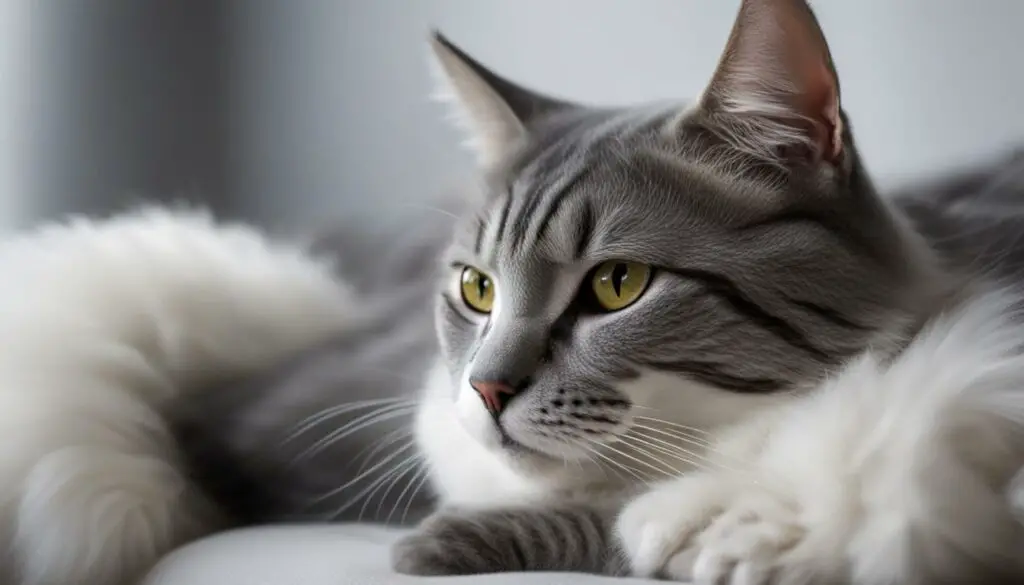
The Pleasure of Kneading
Cats find kneading pleasurable due to the release of endorphins and the sensory stimulation it provides. The repetition of the motion and the pressure exerted on their paws can activate their specialized sensory receptors, leading to a pleasurable sensation. This sensory experience may contribute to the fascination and enjoyment cats display while kneading.
| Reasons for Kneading | Explanation |
|---|---|
| Stimulating milk flow | Instinctive behavior learned during nursing, helping kittens receive milk from their mother |
| Promoting relaxation | Rhythmic motion and pressure provide a soothing effect, helping cats unwind and prepare for sleep |
| Stretching muscles | Kneading helps stretch and flex the muscles in cats’ paws, promoting physical wellbeing |
| Sensory pleasure | Activation of specialized sensory receptors leads to pleasurable sensations for cats |
“Kneading is a behavior deeply ingrained in cats, originating from their early days as nursing kittens. The rhythmic motion serves both functional and emotional purposes, helping kittens stimulate milk production and providing a sense of comfort and contentment. As adult cats continue to exhibit this behavior, it demonstrates their instinctive need for relaxation, stretching, and the sensory pleasure it brings.” – Dr. Amanda Stevens, Feline Behavior Expert
The Influence of Territory and Affection in Kneading
Kneading, a behavior commonly observed in cats, serves multiple purposes beyond expressing affection and trust. It also has a significant influence on territorial marking and emotional bonding between cats and their human companions.
When cats knead on surfaces or even their owners, they leave behind their scent, marking the area as their territory. This territorial marking behavior is an instinctive way for cats to claim ownership and establish their presence in their surroundings.
However, kneading is not solely driven by territorial significance. Cats often knead as a display of affection towards their trusted companions. By engaging in this rhythmic motion, cats symbolize their emotional attachment and reinforce the bond they share with their owners.
| Behavior | Explanation |
|---|---|
| Territorial Marking | Kneading helps cats leave their scent, marking an area as their territory. |
| Affection and Emotional Bonding | Cats knead to show love and strengthen their emotional connection with their human companions. |
Understanding the dual significance of territory and affection in kneading allows cat owners to appreciate this behavior on a deeper level. It highlights the complexity of cats’ motivations and their unique way of expressing love and ownership.
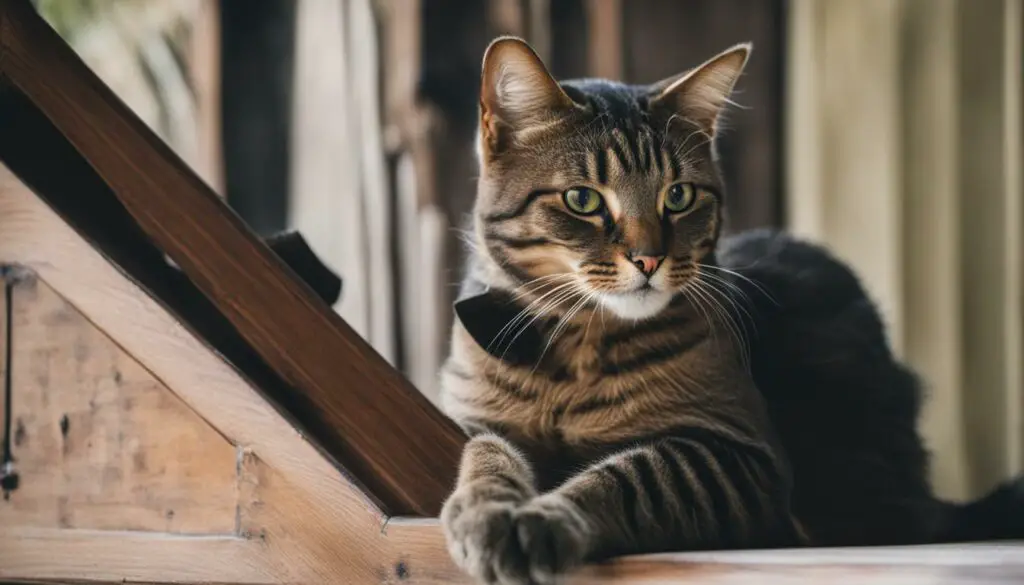
Tips for Encouraging Positive Affectionate Behavior
Encouraging positive affectionate behavior in your cat can strengthen the bond between you and create a harmonious relationship. Here are some tips to help you foster a loving connection:
- Respect their boundaries: Cats are independent creatures and may not always be in the mood for affection. Pay attention to their body language and cues, and give them space when needed. It’s important to let them approach you for attention rather than forcing it upon them.
- Redirection techniques: Provide appropriate surfaces for kneading, such as a soft blanket or cat bed. This will help redirect their attention and minimize discomfort or damage to your furniture. Offering scratching posts and toys can also give them an outlet for their natural instincts.
- Minimize discomfort: Cats have sensitive areas, such as their belly or tail, that may be uncomfortable for them to be touched. Avoid petting or handling these areas if your cat shows signs of discomfort or becomes agitated. Focus on areas they enjoy, such as the head, chin, or behind the ears.
- Positive reinforcement: Reward your cat with treats, praise, or playtime when they display affectionate behavior. This positive reinforcement will help them associate affection with positive experiences and encourage them to seek affectionate interactions in the future.
Remember, each cat is unique, and what works for one may not work for another. Pay attention to your cat’s individual preferences and adapt your approach accordingly. Building trust and fostering a positive environment will create a loving bond between you and your furry companion.

Expert Tip:
“Creating a routine of daily interactive playtime with your cat can help fulfill their need for stimulation and build a stronger bond. Use toys that mimic prey, such as feather wands or interactive puzzle toys, to engage their natural instincts and provide mental and physical enrichment.” – Dr. Lisa Johnson, DVM
Enjoying Your Cat’s Unique Affection Style
Each cat has its own individual personality and unique way of expressing love and affection. It’s important to understand and respect their preferences to create a deep and lasting bond. Whether your cat enjoys cuddling up close or prefers more independent displays of affection, here are some tips to help you appreciate and enjoy your cat’s unique affection style.
Respecting Boundaries
Just like us, cats have personal boundaries and may not always want to be constantly touched or held. It’s essential to recognize and respect their need for personal space. If your cat shows signs of discomfort or tries to move away, allow them to do so. By giving them the freedom to choose when and how they want to engage with you, you’ll build trust and create a stronger connection.
Alternative Ways to Show Love
While physical contact is a common way for cats to express affection, it’s not the only way. Take the time to discover what activities your cat enjoys and incorporate those into your bonding time. This could include interactive play sessions with toys, providing scratching posts and climbing trees for them to explore, or even offering tasty treats as rewards for good behavior. By finding alternative ways to show love and affection that align with your cat’s preferences, you’ll nurture a deeper connection.
Embracing their Quirks
Cats are known for their unique quirks and behaviors. Some may prefer to snuggle up on your lap while others may be content sitting nearby watching your every move. Embrace these quirks and find joy in the little things that make your cat special. Whether it’s their playful antics, their curiosity, or their quiet presence, cherishing these qualities will strengthen the bond between you and your feline friend.
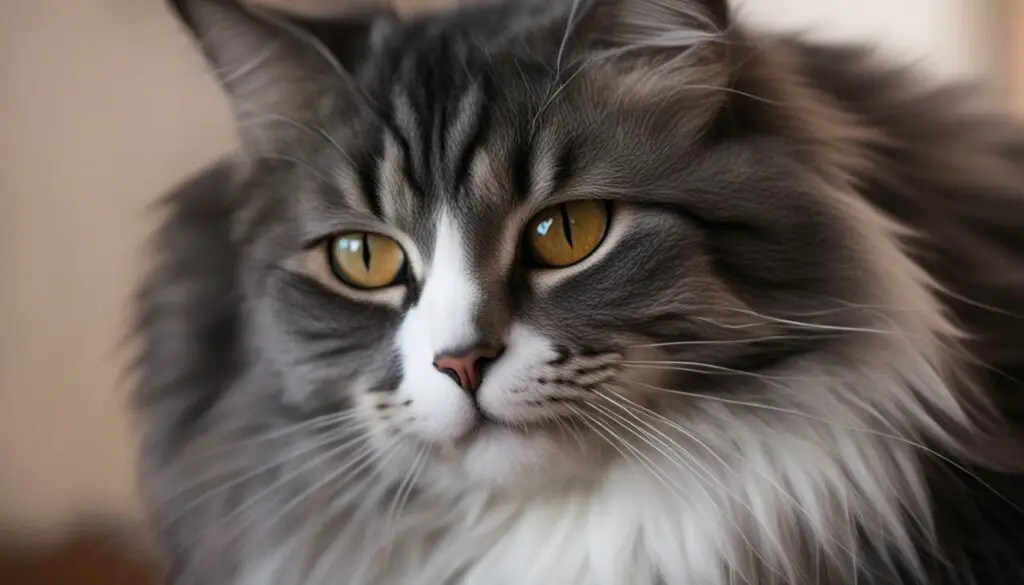
Conclusion
In conclusion, cats’ love for pats stems from a combination of factors. Their social bonding instincts drive them to seek physical contact, deepening their emotional connection with their human companions. The pleasure they experience from tactile stimulation, releasing chemicals like dopamine and oxytocin, further enhances their enjoyment of pats. Additionally, cats use petting as a form of non-verbal communication, expressing their affection and marking their territory.
Kneading, a behavior commonly observed in cats, serves as both a relaxation technique and a way to mark their territory. It originates from their kittenhood when kneading their mothers helped stimulate milk flow. Understanding the reasons behind this behavior allows us to appreciate its significance and emotional value to our feline friends.
To encourage positive affectionate behavior, it is important to respect cats’ boundaries, provide appropriate surfaces for kneading, and offer choice in interactions. By using positive reinforcement and respecting their individual preferences, we can create a loving and comfortable environment for cats to express their unique affection styles.
Ultimately, building a strong bond with our cats requires understanding their needs, communicating through petting and body language, and providing a safe and trusting environment for them to thrive. By nurturing this relationship, we can enjoy a fulfilling and affectionate companionship with our feline friends.
FAQ
Why do cats enjoy pats?
Cats enjoy pats because it provides social and tactile stimulation, strengthening their bond with their human companions. Petting also activates pleasure-inducing chemicals in their brain, leading to feelings of relaxation and pleasure.
How does petting contribute to cat-human communication?
Petting plays a role in non-verbal communication with cats. When a cat rubs against you, it shows affection and marks its territory. Purring is another form of communication that signals contentment and relaxation. Engaging in petting facilitates this communication between cats and their human companions.
Why do cats knead?
Kneading is a behavior commonly observed in cats. It serves as a way for cats to seek attention, promote relaxation, and bond with their trusted companions. Kneading also stems from their kittenhood, where they knead their mothers to promote milk flow.
How can I manage petting-induced aggression in cats?
To manage petting-induced aggression, it is important to have your cat examined by a veterinarian to rule out any medical conditions. Understanding warning signs such as ear position and dilated pupils can help prevent aggressive episodes. Using counter-conditioning techniques and offering rewards for positive behavior can also be effective.
What is the significance of kneading for cats?
Kneading serves multiple purposes for cats. It stimulates milk flow during nursing, promotes relaxation, and helps stretch their muscles. Kneading also has territorial significance, as it allows cats to mark their territory and express affection towards their trusted companions.
How can I encourage positive affectionate behavior in my cat?
To encourage positive affectionate behavior, it is important to respect your cat’s boundaries and offer them choice in interactions. Providing appropriate surfaces for kneading and using redirection techniques can prevent discomfort or damage. Positive reinforcement, such as treats and praise, can also encourage desired behaviors.
How can I enjoy my cat’s unique affection style?
Every cat has a unique personality and affection style. It is essential to recognize and respect your cat’s individual preferences. Find alternative ways to show love and affection that align with their comfort levels, whether it’s through playtime, grooming, or simply being present and attentive to their needs.
Source Links
- https://www.hshv.org/petting-induced-or-overstimulation-aggression-in-cats/
- https://cats.com/why-do-cats-knead
- https://be.chewy.com/my-cat-hates-being-petted-can-i-change-that/




